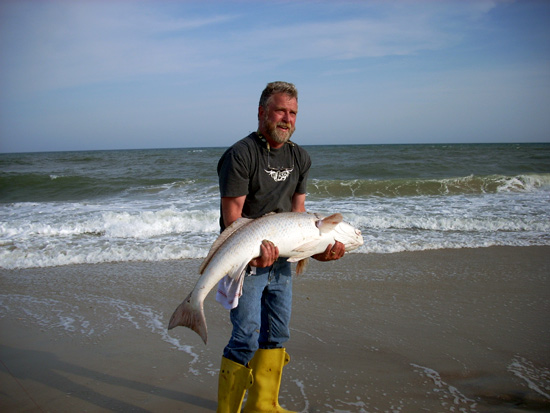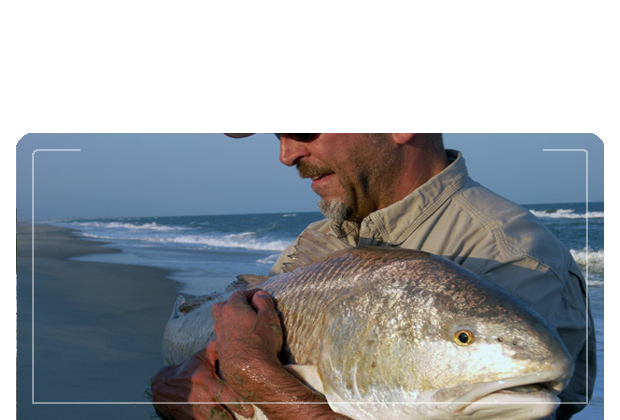How to surf fish for bull reds
Table of contents:
Surf fishing for bull reds can be a challenging and rewarding experience. Here are some tips to help you get started:

Choose the right equipment: A heavy rod with a fast action and a strong, braided line are essential for fighting the powerful bull reds. A long casting rod, such as a 11-12 foot surf rod, will also give you the distance you need to reach the reds.
Select the right bait: Live bait, such as crabs or mullet, is often the most effective for catching bull reds. You can also use cut bait, such as chunks of fish or squid.
Find the right spot: Bull reds are often found in areas with deep channels or drop-offs near the shore. Look for structures, such as jetties or rock piles, that can attract baitfish and, in turn, the bull reds.
Use the right technique: Cast your bait beyond the breakers and retrieve it slowly and steadily, allowing the bait to bounce along the bottom. Pay attention to your line for any bumps or changes in tension, as these could be signs of a bite.
Be prepared for a fight: Bull reds are known for their strength and endurance, so be ready for a long battle when you hook one. Use a strong, steady retrieve to tire the fish out and bring it to shore.
Remember to always follow local regulations and practice catch-and-release whenever possible to help sustain the population of bull reds.
How to land a bull red in the surf
When surf fishing for bull reds, it is important to use the right technique to bring the fish to shore. Here are some additional tips to help you land your catch:
Use a strong, steady retrieve: Bull reds are known for their strength and endurance, so it’s important to use a strong, steady retrieve to tire the fish out and bring it to shore.
Keep a tight line: Maintain a tight line throughout the fight to keep the fish from pulling too hard and breaking your line.
Use a landing net: A landing net can help you safely and efficiently bring the bull red to shore.
Be patient: Bull reds can put up a long and strong fight, so it’s important to be patient and take your time bringing the fish in.
Practice good fish handling: When you finally do bring the bull red to shore, handle it gently and carefully to minimize stress on the fish. Use wet hands or a towel to hold the fish, and avoid squeezing it too hard. When you’re ready to release the fish, gently hold it in the water and allow it to swim away on its own.
How big can these bull reds get

Bull reds can grow to be quite large, with some individuals reaching sizes of up to 50 inches in length and weighing over 50 pounds. However, most bull reds caught by surf anglers are in the 20-40 inch range and weigh between 10-30 pounds. The size of a bull red can vary depending on its age, habitat, and other factors.
It’s worth noting that bull reds are protected by size and catch limits in some areas to help preserve the population. Be sure to check local regulations before fishing for bull reds, and always practice catch-and-release whenever possible to help sustain the population of these impressive fish.
The current International Game Fish Association (IGFA) all-tackle record for a bull red (also known as a red drum) is a fish caught in Virginia Beach, Virginia, in 1984 that weighed 94 pounds, 2 ounces. This fish measured just over 47 inches in length and had a girth of 37 inches.
It’s worth noting that bull reds of this size are rare and catching a fish of this size is considered a once-in-a-lifetime event for most anglers.
More about bull reds habitat
Bull reds, also known as red drum, are found along the Atlantic Coast of North America from Massachusetts to Florida, and around the Gulf of Mexico and the Caribbean.
Bull reds are typically found in shallow, inshore waters, including bays, estuaries, and the surf zone along the beaches. They prefer areas with soft, sandy bottoms and can often be found near structures such as jetties, pilings, and reefs. Bull reds are also known to move into deeper waters during the winter months.
Bull reds are opportunistic feeders and will eat a variety of prey, including crabs, shrimp, and small fish. They are known to use their sensitive barbels (whisker-like structures) to locate prey in the sand and mud.
The habitat and behavior of bull reds can vary depending on the specific location and the time of year. It’s important to consider these factors when planning a surf fishing trip for bull reds.
What’s the best bait to catch bull reds
The best bait for catching bull reds, also known as red drum, can vary depending on the specific location and the time of year. In general, live bait is often the most effective for catching bull reds. Here are a few options to consider:
Crabs: Bull reds are known to be attracted to crabs, so using live or fresh-cut crabs as bait can be very effective.
Mullet: Live mullet, either whole or cut into chunks, is another good bait option for bull reds.
Shrimp: Live or fresh-cut shrimp can also be a good bait choice for bull reds.
Other live bait: Other live bait options for bull reds include worms, minnows, and other small fish.
In addition to live bait, you can also try using cut bait, such as chunks of fish or squid, to catch bull reds. Experiment with different bait options to see what works best in your location.
It’s important to remember to always follow local regulations when using bait, and to dispose of any unused bait properly to avoid negative impacts on the environment.
To Summarize
Choose the right equipment: A heavy rod with a fast action and a strong, braided line are essential for fighting the powerful bull reds. A long casting rod, such as a 11-12 foot surf rod, will also give you the distance you need to reach the reds.
Select the right bait: Live bait, such as crabs or mullet, is often the most effective for catching bull reds. You can also use cut bait, such as chunks of fish or squid.
Find the right spot: Bull reds are often found in areas with deep channels or drop-offs near the shore. Look for structures, such as jetties or rock piles, that can attract baitfish and, in turn, the bull reds.
Use the right technique: Cast your bait beyond the breakers and retrieve it slowly and steadily, allowing the bait to bounce along the bottom. Pay attention to your line for any bumps or changes in tension, as these could be signs of a bite.
Be prepared for a fight: Bull reds are known for their strength and endurance, so be ready for a long battle when you hook one. Use a strong, steady retrieve to tire the fish out and bring it to shore.
Follow local regulations and practice catch-and-release: Always follow local regulations and practice catch-and-release whenever possible to help sustain the population of bull reds.
Tight lines!
I research and report on fishing, fishing gear/equipment, survival topics, and marketing for outdoors related businesses. I assist here on CB Fishing as the editor. Articles may contain AI researched content. All content is published for education and entertainment purposes only, NOT LIFE, HEALTH, SURVIVAL, FINANCIAL, BUSINESS, LEGAL OR ANY OTHER ADVICE. Learn more about Mark Mayo
- Guide to starting a Fishing Charter business
- Carolina Beach Local Fishing Reports #94RT
- Strategic Fishing Charter Marketing
- Carolina Beach Local Fishing Reports #83RT
- Carolina Beach Local Fishing Reports #73RT
- East Coast Got Em On King Mackerel Tournament 2023
- 2023 Recreational Flounder Season Announced
- Carolina Beach Local Fishing Reports #63RT
- Beginner’s Guide: Your First Fishing Trip in Carolina Beach
- Carolina Beach Fishing Reports #53RT
- King Mackerel Fishing in Carolina Beach, NC: A Comprehensive Guide
- Current Fishing Report and Trends and new “Big Red” Artwork
- Surf Fishing in Carolina Beach, North Carolina
- What Do Redfish Eat? A Comprehensive Guide
- Early Spring 2023 Carolina Beach Fishing Report
- My Top 10 fish to catch at Carolina Beach, NC!
- What are the Most Popular Fishing Spots in Wilmington, NC?
- Flounder in the Cape Fear River
- Striped bass in the Cape Fear River
- What’s so special about The Cape Fear River?
- Top 4 fish to target in Carolina Beach, NC
- East Coast Got Em On King Mackerel Tournament starts to wind down
- 2022 ranking results – East Coast Got Em On King Mackerel Tournament
- Flounder Season shortens for 2022


